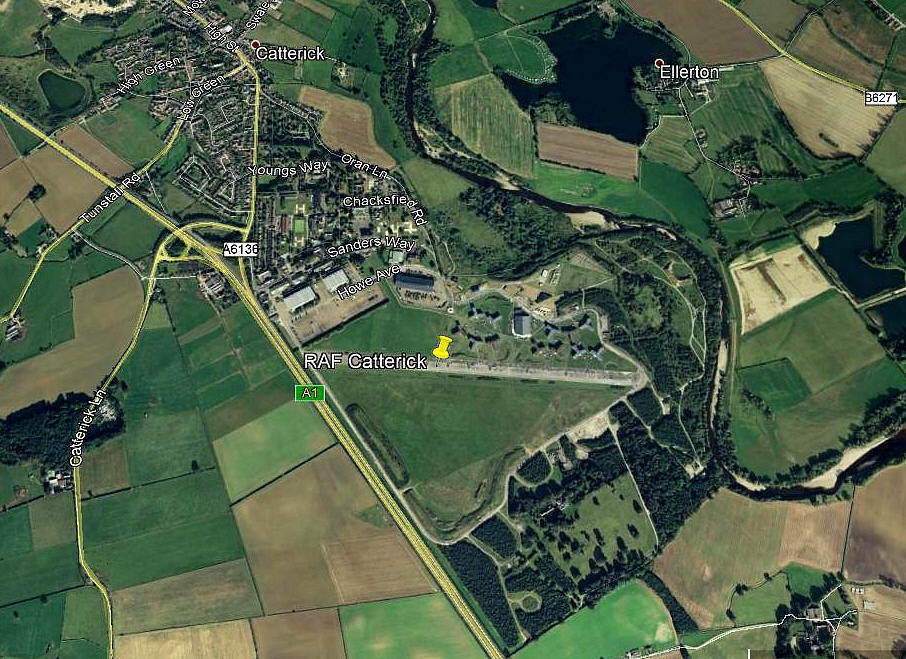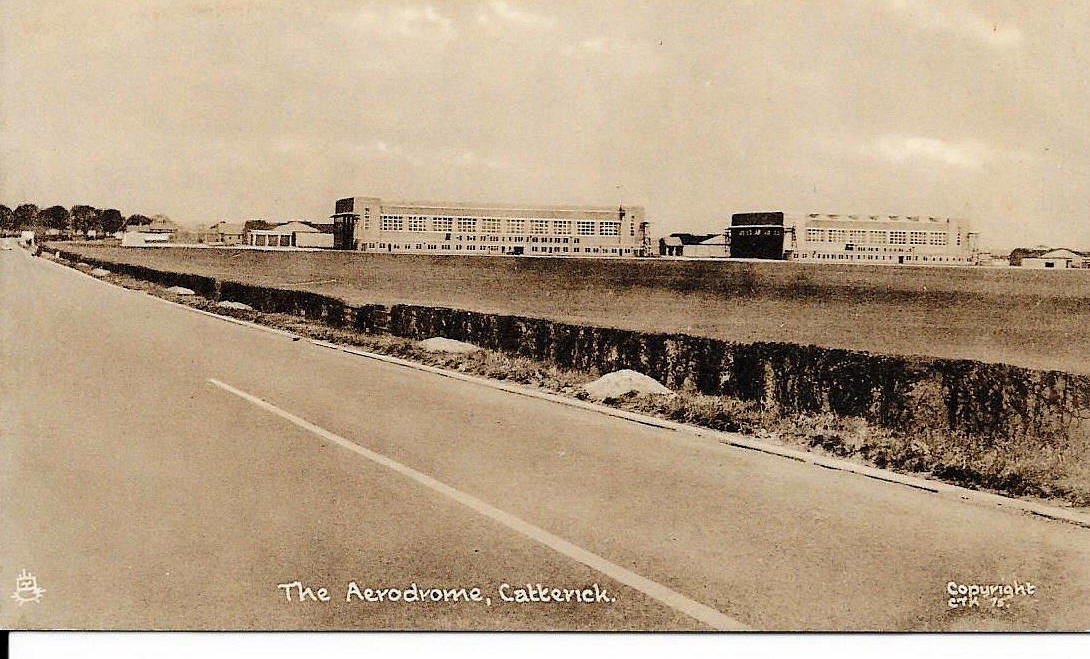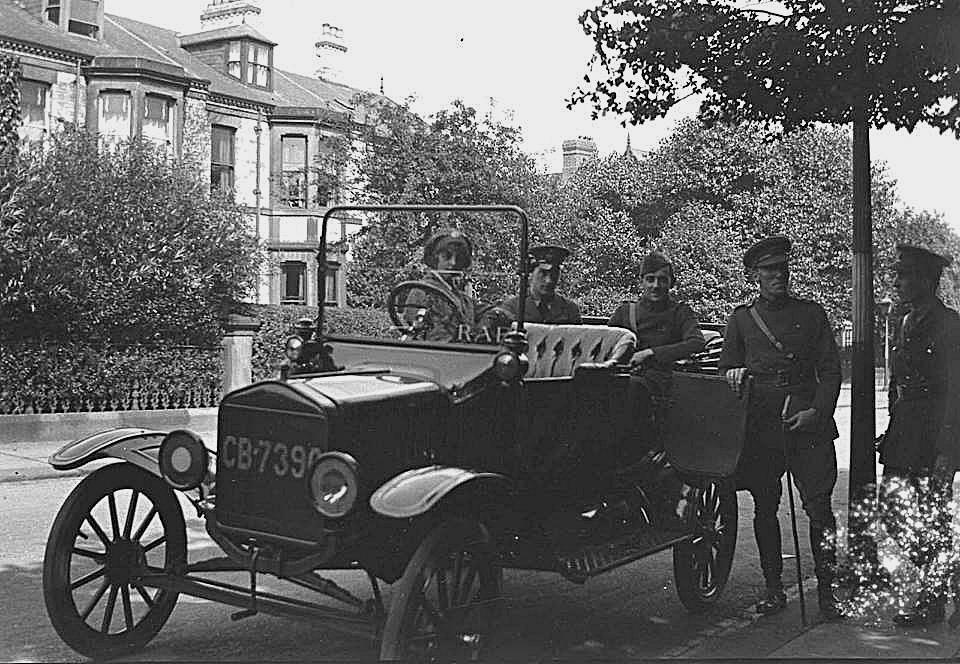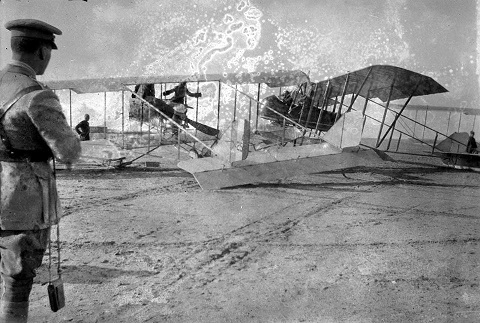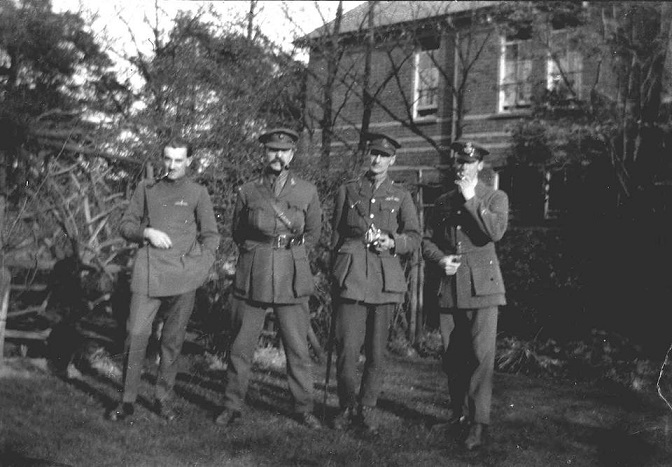Catterick
*CATTERICK: Military aerodrome (Forward airfield in WW2)
(Also once known as CATTERICK BRIDGE?)
Note: This picture (2009) was obtained from Google Earth ©
Military users: WW1: RFC/RAF Home Defence Flight Station, Reserve and Training Station.
1918: RAF Training Depot Station
33 (Home Defence) Sqdn (BE-2Cs)
76 (Home Defence) Sqdn (BE.2Cs, BE.12Cs and later Bristol F.2Bs)
115 Sqdn (Handley Page 0/400s*)
Note: This evocative picture, from a postcard, and taken from the A.1 trunk road, was kindly supplied by Mike Charlton who has an amazing collection of British aviation postcards. See; www.aviationpostcard.co.uk
Between the wars:
From 1927 it appears under RAF Army Co-operation Command until July 1939
RAF Fighter Command from September 1939
(1936) 41 Sqdn (Hawker Furys)
(Later 41 Squadron was the 3rd RAF Squadron to receive Spitfires)
WW2: RAF Fighter Command 13 Group
54 Sqdn (Vickers-Supermarine Spitfires)
*Battle of Britain RAF Sector Station
(10th July 1940) 41 Sqdn (Vickers-Supermarine Spitfires)
54 Sqdn (Spitfires)
219 Sqdn (Bristol Blenheims)
(1st August 1940) 54 Sqdn had replaced 41 Sqdn, also flying Spitfires.
Note: When I started this research many, many years ago it appeared to me that 41 Sqdn seemed to have disappeared from front-line action? Quite the opposite seems to be case as they had been transferred to HORNCHURCH in ESSEX which was in the thick of the action during the so-called ‘Battle of Britain’. On the 1st September 1940 it appears 41 Sqdn were back again, and, apparently the only Sqdn based here.
What I had not realised was that during WW2 certain ‘top brass’ elements within the Air Ministry and RAF had developed a mania for continuously moving squadrons around the UK. It was costly in every aspect, very unsettling for all on operations and, obviously, counter-productive to the war effort. Don’t forget, moving a squadron did not just entail flying aircraft to another place. As I understand it, everything had to be shipped out – the admin, maintenance crews, and probably nigh on everything bar the kitchen sink!
OTHER SQUADRONS BASE HERE IN WW2
331 (Norwegian) Sqdn (Hawker Hurricanes)
41, 130 (Punjab), 145 & 306 (Polish) Sqdns (Vickers-Supermarine Spitfires)
Gliding: 1997: Army 645 VGS (gliding also listed in 1975). It appears that 645 VGS were operating here until about 2018/19 before transferring to Allanbrook Barracks, which was RAF TOPCLIFFE.
Location: E of A1, in/near Catterick, 4nm SE of Richmond
Period of operation: 1914 to 198? Listed as being open for communicatons aircraft in 1975
Site area: WW1: 240 acres 1463 x 704
Runway: WW2: 10/28 1097x46 hard
A JOHN D-ALLEN GALLERY
In April 2018 John very kindly sent me some pictures taken in and around CATTERICK in WW1.
First picture: I notice that this car has 'RAF' painted on the windcreen, and the driver appears to be a women? If so, perhaps unusual in that era? As the RAF was formed on the 1st April 1918, this picture clearly dates from a slightly later period. Just out of interest, can anybody kindly identify this vehicle.
Second picture: The aircraft in the foreground is, I reckon, a Farman MF.II Shorthorn. Intoduced into service in Mar 1914 could this type still be in service at CATTERICK in 1918?
Third picture: Of interest, I think, are two pictures on the wall of aerial photographs of CATTERICK. I wonder if anybody today can kindly offer advice regarding this picture?
Fourth picture: Here again, can anybody kindly offer advice as to who these officers were?
NOTES: Here we go again! Yet another little nagging question thrown up by official records. On 16/12/1915 2nd Lieut. Alfred Ellison was awarded his Pilot Certificate No.2249 flying a Maurice Farman biplane and the record shows the location as being CATTERICK BRIDGE.
There is another point worth making because this is one of very last entries shown in Jane’s ‘All the Worlds Aircraft’ 1917 edition. From then on the practise of publishing these records stopped as it was considered it could provide too much information to the enemy regarding how many pilots were on strength. Looked at with hindsight this decision hardly makes much sense because the life expectation of most pilots in WW1 was often measured in days, let alone weeks, especially if they started flying on the ‘Western Front’.
*A WARNING
Anybody today deciding to investigate British military aviation history in depth probably “needs their bumps felt”. It will probably drive you mad!
For example, depending on which history version you read all seem to agree that 115 Sqdn were formed here on the 1st December 1917. All versions agree they flew the Handley Page 0/400. However, I discovered one history that says 115 Sqdn did not get any of these aircraft until they arrived at NETHERAVON (WILTSHIRE) in April 1918. Another version says that no pilots arrived at 115 Sqdn until August 1918 when they were then based at CASTLE BROMWICH (WEST MIDLANDS). Can you make any sense of this?
THE DEPENDABLE ATLAS
The Armstrong Whitworth Atlas (Army Co-operation type) first entered RAF service here with No.26 squadron in October 1927.
It now appears that during 1935, and perhaps a bit later, this airfield was largely re-built. The existing buildings being mostly demolished and replaced, in accordance with the expansion programme.
SOME QUERIES
There is a record that shows Mr J.T.H. Baldwin owned and presumably flew a Cranwell C.L.A.4A (G-EBPB) from Catterick in 1930 and possibly for a year or two later. Was this based here or at a private airfield nearby?
For many years a variety of aircraft, (in the 1970s and 80s - mainly if not totally non-operational types) were stored here both in the open and in the hangars. In 1977 the DH.82A Tiger Moth G-ANEL was based here.
Still in use as a military Army base today but powered flying appears to have ceased in the late 1970s?
Henry Shepherd
This comment was written on: 2018-08-29 17:17:39My grandfather's scrap book has MF Longhorns in 1916. I can try to scan photos.
Reply from Dick Flute:
Hi Henry, Any pictures will be most welcome. Please send by e-mail. Best regards, Dick
We'd love to hear from you, so please scroll down to leave a comment!
Leave a comment ...
Copyright (c) UK Airfield Guide















